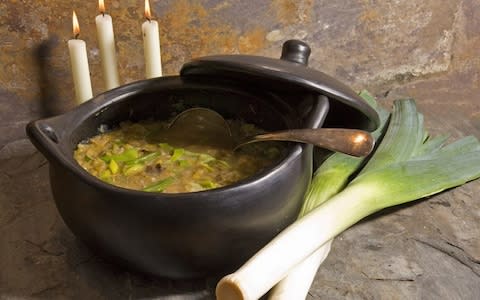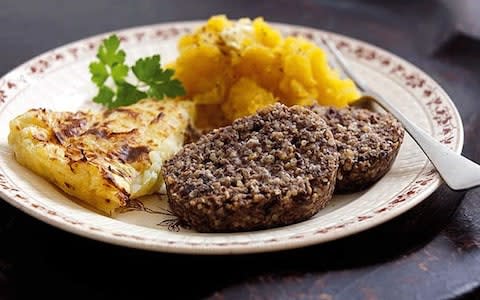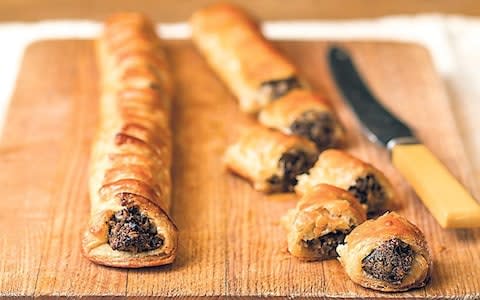Burns Night 2019: How Scottish favourite haggis could have English roots

Burns Night, held in honour of Scotland's most famous poet Robert Burns, is celebrated at the end of January every year. The night is a way to remember the life of the 18th century bard and it falls on his birthday – January 25.
The tradition started a few years after the poet's death in 1796, when his friends commemorated his career on the date of his death (July 21) each year.
So began the Burns Supper, and more than two centuries later it is has become a nationwide event with recitals of the poet's works and a haggis dinner. But who was the poet, how is the night traditionally celebrated – and how can you create a Burns night of your own?
Who was Robert Burns?
Of all the poets who have written in the Scottish language, Burns is most well-known, although much of his writing is also in standard English and a light Scots dialect.
Also known as Rabbie Burns, the Bard of Ayrshire, the Ploughman Poet and various other names and epithets, he's widely regarded as being the national poet of Scotland and a pioneer of the Romantic movement.
Born on January 25 1759, Robert Burns was a Scottish poet and lyricist. Born in Ayrshire to Agnes and William Burnes, he grew up on a farm and was educated by both his father and a tutor. The family was poor and when his father died, penniless, and Robert was put in charge of the farm.
He began writing poetry while ploughing the fields; two of his most famous works - "To a Mouse" and "To a Mountain Daisy" are said to have been written during this period; in fact, he apparently wrote "To a Mouse" while still holding his plough after accidentally destroying a mouse's nest.

The poet also wrote songs and is said to have been able to play the stock-and-horn, the violin and the guitar.
However Burns was much more interested in women and soon became somewhat of a ladies man: while involved with Jean Armour, his affair with his mother's servant Elizabeth Paton resulted in his first child in 1784; the next year Armour gave birth to his twins.
Around the same time, Burns also became involved with Mary Campbell - who inspired the poems "The Highland Lassie O", "To Mary in Heaven" and "Highland Mary".
Struggling for money, Burns made plans to move to Jamaica to work as a bookkeeper on a slave plantation - a role he may have struggled with, considering the forward-thinking, abolitionist views he expressed in his song "The Slave's Lament":
It was in sweet Senegal that my foes did me enthral,
For the lands of Virginia,-ginia, O:
Torn from that lovely shore, and must never see it more;
And alas! I am weary, weary O:
Torn from that lovely shore, and must never see it more;
And alas! I am weary, weary O.All on that charming coast is no bitter snow and frost,
Like the lands of Virginia,-ginia, O:
There streams for ever flow, and there flowers for ever blow,
And alas! I am weary, weary O:
There streams for ever flow, and there flowers for ever blow,
And alas! I am weary, weary O:
The burden I must bear, while the cruel scourge I fear,
In the lands of Virginia,-ginia, O;
And I think on friends most dear, with the bitter, bitter tear,
And alas! I am weary, weary O:
And I think on friends most dear, with the bitter, bitter tear,
And alas! I am weary, weary O:
To pay for his voyage, Burns published his poems in a book known as the Kilmarnock Volume. The works became an immediate success and the published poet put aside his plans for Jamaica, instead setting off for Edinburgh where he found literary acclaim.
After protestations from her father, Armour and Burns eventually married in 1788; over their life together she gave birth to nine children, although only three survived. Over the years he continued to publish poems, working on farms and as an excise officer to support his family financially.
However Burns only lived until the age of 37. A lifetime of poor health due to his weak heart and frequent drinking resulted in his early death on July 21 1796 from rheumatic fever.
Born into poverty, he never escaped financial strife: when his tailor found out he was dying, he presented him with a bill on his deathbed.
The poet's funeral took place four days later, on the day Armour bore his first son, Maxwell. By the time of his death, Burns had bore 12 children by four different women.
Why is his work still so popular?
After his death in 1796 Burns became a great source of inspiration to the founders of both liberalism and socialism, as well as a cultural icon in Scotland and among the Scottish diaspora around the world.
His love of the Scots language secured his reputation as a beloved national figure, as he helped re-popularise the vernacular in literature.
His gift for writing enduring romantic poems and songs that have continued to resonate with people over the centuries is no doubt linked to his many affairs, as well as his respect for the opposite sex: influenced by the work of prominent feminist Mary Wollstonecraft, he was a keen advocate for women's rights.

Burns' success can be put down to his writing about relatable topics: musings on class, sex and patriotism run through most of his work. He also filled his poems with humour and tales of working, drinking and marital strife.
Celebration of his life and work became almost a national charismatic cult during the 19th and 20th centuries, and his influence has long been strong on Scottish literature. In 2009 he was chosen as the greatest Scot by the Scottish public in a vote run by Scottish television channel STV, narrowly beating William 'Braveheart' Wallace.
Robert Burns wrote Auld Lang Syne ... sort of
Robert Burns didn't invent "Auld Lang Syne" as we know it; rather he was the first person to write down a much older Scottish folk song.
While the Scottish Bard wrote many wonderful pieces of original verse, this was not among them. Instead, he was the first person to write down a much older Scottish folk song.
In 1788 he sent a copy of the song to his friend, Mrs Agnes Dunlop, exclaiming: "There is more of the fire of native genius in it than in half a dozen of modern English Bacchanalians!"
Five years later he sent it to James Johnson, who was compiling a book of old Scottish songs, The Scottish Musical Museum, with an explanation: "The following song, an old song, of the olden times, and which has never been in print, nor even in manuscript until I took it down from an old man."
By the time Johnson published it, most likely attributing the verse to the globally known tune, Burns had been dead for a few months. The most famous section of the poem goes:
Should auld acquaintance be forgot,
And never brought to mind?
Should auld acquaintance be forgot,
And auld lang syne!Chorus:
For auld long syne, my dear,
For auld long syne,
We'll tak a cup o' kindness yet,
For auld lang syne.
The poem (and song) "Auld Lang Syne" is often sung at Hogmanay (New Year's Eve), and "Scots Wha Hae" served for a long time as an unofficial national anthem of the country.
However the tune that springs to mind when you see the words is not necessarily the original one. Although it's thought that the tune Burns originally heard is probably now forgotten, the poet did write another song with a very similar melody, called O Can Ye Labour Lea, Young Man.
There is another, reportedly more traditional tune, that Auld Lang Syne is set to. If sources are to be believed, it's the version featured in the Sex and the City film in 2008 and a more haunting, nostalgic and beautiful version of the jaunty singalong everybody is used to.
Traditional Scottish folk singers still perform this version, and who can blame them - it's far more refined.
How Burns inspired our greatest writers
Burns collected folk songs from across Scotland, often revising or adapting them, as well as making original compositions. Among his most popular original compositions are A Red, Red Rose, which is said to have inspired Bob Dylan's writing.
A Red, Red Rose
O my Luve's like a red, red rose,
That's newly sprung in June:
O my Luve's like the melodie,
That's sweetly play'd in tune.As fair art thou, my bonie lass,
So deep in luve am I;
And I will luve thee still, my dear,
Till a' the seas gang dry.
Till a' the seas gang dry, my dear,
And the rocks melt wi' the sun;
And I will luve thee still, my dear,
While the sands o' life shall run.
And fare-thee-weel, my only Luve!
And fare-thee-weel, a while!
And I will come again, my Luve,
Tho' 'twere ten thousand mile!
His poem "Comin' Thro' the Rye" was the inspiration for J. D. Salinger's Catcher in the Rye; plus a line from the penultimate stanza of"To a Mouse" inspired the title John Steinbeck's Of Mice and Men:
But Mousie, thou art no thy lane,
In proving foresight may be vain:
The best-laid schemes o' Mice an' Men
Gang aft agley,
An' lea'e us nought but grief an' pain,
For promis'd joy!
How is Burns night celebrated?
Whether or not Burns would have worn a kilt is still disputed, with some arguing that as a lowlander he would not have worn them - although he was a champion of the right to wear traditional dress.
The full ritual of the night involves whisky, haggis and poetry readings. Those who partake are piped in and then The Selkirk Grace – the prayer of thanks attributed to Burns – is said before dinner.
The prayer goes:
Some hae meat and canna eat,
And some wad eat that want it;
But we hae meat, and we can eat
Sae let the Lord be thankit.
A traditional Burns Supper starts with soup, often a Scottish broth. The haggis is then served with turnips and potatoes – known as neeps and tatties if you're a true Scot. The haggis, typically carried on a silver salver, is also piped in by the diners with a standing slow clap.
It is the "Great chieftain o the puddin’-race" according to the "Address to the haggis". During the Address (also written by Burns) the speaker draws a knife and at the line “An’ cut you up wi’ ready slicht”, cuts the dish open. Once all the fanfare is over, the guests toast the haggis and tuck in.
The meal is followed by the Immortal Memory toast, in which a guest gives a speech in honour of the great poet. Then a Toast to the Lassies, once a chance to thank the women cooking the meal, it is now the humorous highlight to the evening. A male diner offers an amusing but complimentary take on the role of women in general life, taking in quotes from Burns's works and referring to women in the group.
Any man making the toast should tread with care, since it is followed by a reply from the women.
The rest of the night is filled with a vote of thanks and guests performing works by Burns, ending with the Auld Lang Syne. The group stand and holds hands to sing it.
Could haggis actually be English?
While the dish might be Scottish favourite, it might actually have English roots. A 1430 cookbook called Liber Cure Cocorum from Lancashire contains the earliest known recipe for haggis.
The meal is a savoury pudding, made from a mixture of sheep's heart, liver, and lungs, oatmeal, onion, suet and stock. While for centuries it was served in the animal's stomach, that tradition has died (fortunately) out.
Leading food historian Catherine Brown believes that Scottish nationalists may have appropriated haggis as a symbol of their nationhood in the decades following the Act of Union with England in 1707.
"It seems to be that there's an identity thing there. We'd lost our monarchy, we'd lost our parliament and we gained our haggis," she said.
"There was a latching onto everything that was distinctive about Scotland, and Burns had identified the dish in such an evocative way."
She added Burns claimed the pudding as Scottish with his poem "Address to a Haggis" in 1787 because it was a thrifty contrast to the elaborate and pretentious French cuisine popular in Edinburgh at the time.
Six things you didn't know about haggis
It's a Scottish favourite, but most haggis isn't even consumed in Scotland. According to Macsween, over 60 per cent of the 1000 tons of haggis they make is sent to England each year - with the dish selling particularly well in London.
Despite the $1000 fine for anyone caught smuggling haggis into America, there's allegedly a multimillion dollar haggis smuggling ring dedicated to getting Scottish expats their haggis. The dish was banned in America in 1971, with officials stating it was unfit for human consumption.
Haggis hurling is a thing. Really. In June 2011, Lorne Coltart set the record, hurling his haggis an impressive 217 feet.
An ancient version of haggis is mentioned in Homer's Odyssey, "a man before a great blazing fire turning swiftly this way and that a stomach full of fat and blood, very eager to have it roasted quickly".
The world's biggest haggis was made by Halls of Scotland and weighs 2,226 lb 10 oz - that's as much as a small car.
Recipes for a Burns night supper

A perfect starter for your Burns Night festivities is cock-a-leekie soup. Rich and warming, this version simply uses three ingredients - chickens, leeks and prunes - and is easy to whip up.

Burns Night celebrations wouldn't be complete without haggis. Our food writer Xanthe Clay's recipe is served with a twist on the classic neeps and tatties, and a fruity red berry sauce.

If you want to include haggis in your celebrations, but are wary of making it the main course, how about these wee haggis and whisky rolls? They make an excellent canape if you're having a big shindig.

A classic beef stew shows off Scottish cooking at its best - rich and wholesome. Top-quality Aberdeen Angus beef will really make this dish shine.

When it comes to dessert, the classic Burns Night choice is cranachan - a delicious mix of cream, raspberries, toasted oatmeal and a splash of whisky. What's not to like?

 Yahoo News
Yahoo News 
